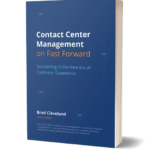I recall a new restaurant with great food and impeccable service that quickly built a following. Referrals spread rapidly, reviews were positive, and before long, the waits to get in became longer.  To customers, this was just confirmation the restaurant was a great choice. But over time, the food became less predictable, the service less consistent. They became complacent. And the word of mouth that was working for them began to work against them. In less than two years, they were out of business.
To customers, this was just confirmation the restaurant was a great choice. But over time, the food became less predictable, the service less consistent. They became complacent. And the word of mouth that was working for them began to work against them. In less than two years, they were out of business.
Can this same complacency happen in your organization? Of course—but you can avoid it and instead build a culture that is fun, focused, and passionate about the customer experience. What do organizations with the most customer-focused cultures have in common? Here are some traits that really stand out:
They establish a unifying vision.
A vision and supporting strategy that pulls everyone together is critical. In The Service Culture Handbook, Jeff Toister states it well: “A customer service vision is the cornerstone of a customer-focused culture. It acts as a compass to get every employee pointed in the same direction.”
They hire the right people.
I had a successful customer service leader put their approach to me this way: “We hire the passion and train the skills.” I agree with this approach— while it makes sense (when possible) to recruit employees who have the skills you need, a drive and passion to help customers is a must-have.
They put their employees first.
Southwest Airlines, one of the world’s most admired companies, states on their website that “In our ‘order of importance,’ we put our Employees first, then our Customers, then our Shareholders … We believe that, if we treat our Employees right, they will treat our Customers right, and in turn that results in increased business and profits that make everyone happy.” They also empower employees to make real-time decisions. You can’t expect them to be effective unless they have the authority and means to help customers.
They communicate effectively.
Effective leaders at all levels, whether CEOs or supervisors of a group, keep their teams in the know. Good or bad, nobody is second-guessing or wondering. Effective leaders listen, intently and often. And they celebrate successes along the way.
They keep the focus on customers rather than internal objectives.
A large cable company with a mixed reputation for service (that they are working hard to change) recently took the symbolic step of putting an empty chair in every planning meeting, to represent the customer. Those involved say it really means something to have a tangible picture of a customer sitting in those discussions. It’s beginning to have an impact. (A utility goes even further—they bring in customers to talk to new customer service agents, and tell them things they like and things they would change about their experiences.)
They establish goals and objectives that support a customer-focused culture.
Here’s an example I witnessed recently. A chain of hardware stores that set “the number of customers served” as a key performance factor realized they were missing opportunities. As they learned, the employee who points to the aisle where the wrenches are is not nearly as effective as one who walks the customer to the aisle, asks whether they have an Allen wrench to install the part they requested and, in the process, discovers that the project is part of a larger remodel. With a renewed focus on customers (and retooled performance metrics), this chain is seeing both customer satisfaction and business returns improve.

Excerpt from Contact Center Management on Fast Forward by Brad Cleveland.



0 Comments